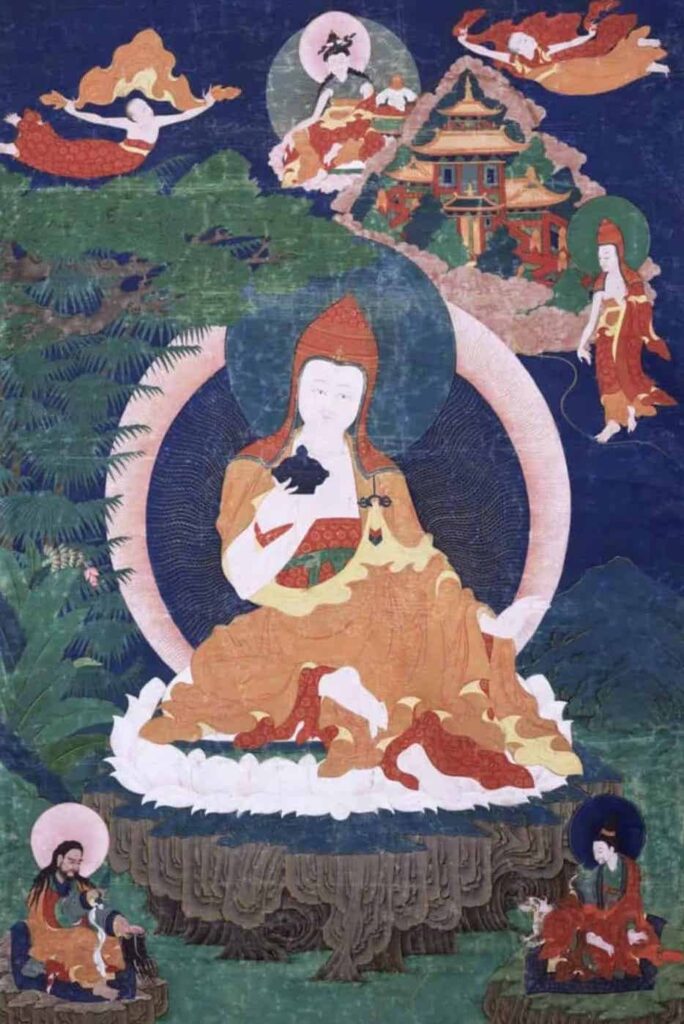In Tibetan Buddhism, we celebrate the 10th day of each lunar month as Guru Rinpoche Day. Guru Rinpoche or Padmasambhava is the Buddha who established Vajrayana Buddhism in Tibet. On the outer level, the Mahaguru is the essence of all buddhas and lineage masters.
On the tenth day of the tenth month, the rat month, when he arrives in central Tibet, subjugates all the wild unruly gods and spirits of Tibet, raises the Dharmacakra of glorious Samyé, lights the lamp of the sacred Dharma of sūtras and tantras, and ripens and liberates the fortunate ones, the king and his subjects, he is known as Guru Padmasambhava.
…
Especially on the tenth-day festival, I, Orgyen,
From The Concise Benefits of the Festival of the Tenth Day by Kyabjé Dudjom Rinpoche.
Will come to Tibet, the land of snows, and be present everywhere,
Riding on the rays of sun and moon, and the droplets of moisture in the rainbow,
Clearing away the obstacles of my devoted children,
Granting the four empowerments just as you desire.
This is my solemn pledge; and Padma never deceives, this I swear.
If you are devoted to me, practice continually on every tenth day,
And by acting according to my instructions, the whole country will enjoy happiness and well-being.
On every tenth day of the lunar month, we can reflect on the testament left by Guru Rinpoche himself. When we read these profound reminders, we can also make the aspiration that the activities begun by Padmasambhava continue to flourish in our own time and far into the future. In this way, the light of Dharma lit at Samyé may continue to bring benefit to beings as far as space pervades.
In this fifth chapter of one auto-biography, we find the following account:
དེ་ནས་བོད་ཡུལ་ལྷ་འདྲེ་ཐམས་ཅད་བསྡུས༔
Then I summoned every god and demon in the kingdom of Tibet,བཀའ་བསྒོས་དམ་བཞག་ས་གཞི་བྱིན་གྱིས་བརླབས༔
Gave them orders, bound them to oaths, and consecrated the whole land.རྡོ་རྗེའི་འགྲོས་བྱས་ཧཱུྂ་གིས་དབང་དུ་བསྡུས༔
With vajra dance and song of hūṃ, they were brought under my command.བསམ་ཡས་རྨང་བཞག་ཉིན་མོ་མི་ཡིས་བརྩིགས༔
During the daytime, the people laid down Samyé’s foundations,མཚན་མོ་ལྷ་འདྲེ་རྣམས་ཀྱིས་བརྩིགས་བྱས་ཏེ༔
But the gods and demons built throughout the night.རྒྱལ་ཆེན་སྡེ་བཞི་རྣམས་ཀྱིས་ལས་དཔོན་བྱས༔
The Four Great Kings assisted, supervising their work;ཀུ་ཅོའི་སྒྲ་དང་བཅས་པས་གྱང་བཏང་ངོ་༔
And as the walls went up with joyful, clamorous song,ཉིན་མོ་མི་བས་མཚན་མོ་ལྷ་འདྲེའི་མཐོ༔
Gods and demons raised them even higher at night than humans by day!བར་དེར་རྒྱལ་པོ་ཀླུ་དང་ཤག་པོ་བྱས༔
Meanwhile, between the king and nāgas a covenant was made,ཀླུ་ལ་གྲོགས་བཅོལ་གསེར་ཕྱེས་ལུང་པ་བཀང་༔
And the nāgas were assigned to fill the land with golden dust.བསམ་ཡས་བརྩིགས་པ་མི་འདྲ་སྐྱེས་པ་འདྲ༔
Samyé was constructed according to different designs:དབུ་རྩེ་རིམ་གསུམ་རི་རབ་ཚུལ་དུ་བྱས༔
The central temple with three stories was built like Mount Meru,ཡཀྴ་ལྟག་འོག་ཉི་མ་ཟླ་བའི་ཚུལ༔
The two yakṣa temples like the sun and moon,གླིང་ཆེན་བཞི་དང་གླིང་ཕྲན་བརྒྱད་ཀྱིས་བརྒྱན༔
And the whole was ornamented with the four continents and eight minor isles.ལྕགས་རིའི་སྟེང་ན་མཆོད་རྟེན་བརྒྱ་རྩ་བརྒྱད༔
One hundred and eight stūpas placed upon the Iron Mountain wall,རྡོ་རིང་བཞི་ལ་ཟངས་ཀྱི་ཁྱི་མོ་བཞི༔
And four female dogs of copper were set upon four stone pillars.ཐོག་གསུམ་རྒྱ་གར་རྒྱ་ནག་བོད་ཀྱི་ལུགས༔
The three stories were made in the styles of India, China and Tibet.སྟེང་ཁང་གཙོ་བོ་ཀུན་ཏུ་བཟང་པོ་ལ༔
Samantabhadra was the central figure in the upper story,རྣམ་སྣང་མངོན་བྱང་དཀྱིལ་འཁོར་ལྷ་ཚོགས་བཞུགས༔
With the maṇḍala of Vairocana’s Awakening.བར་ཁང་གཙོ་བོ་རྣམ་པར་སྣང་མཛད་ལ༔
In the middle story, the chief figure was Vairocana,རྡོ་རྗེ་དབྱིངས་ཀྱི་དཀྱིལ་འཁོར་ལྷ་ཚོགས་བཞུགས༔
Surrounded by the deities of the Vajra Space Maṇḍala.འོག་ཁང་གཙོ་བོ་བྱང་ཆུབ་ཆེན་པོ་ལ༔
Central on the ground floor was the Great Awakened One,ཕྱོགས་བཅུའི་སངས་རྒྱས་ཉེ་སྲས་མ་ལུས་བཞུགས༔
With all the buddhas of the ten directions and their closest heirs.གཙུག་ལག་ཁང་ལ་རབ་གནས་མེ་ཏོག་འཐོར༔
All the temples were consecrated, flower petals strewn,ལྷ་རྣམས་ཀུན་ལ་ཡེ་ཤེས་མངོན་སུམ་ཕེབས༔
And wisdom deities descended into every statue for all to see.འོད་ཟེར་འབར་དང་རོལ་མོའི་རང་སྒྲ་བསྒྲགས༔
Rays of light blazed forth and the sound of music was heard.ལྷ་རྣམས་ཀུན་གྱིས་མེ་ཏོག་ཆར་པ་ཕབས༔
All the gods showered down a rain of flowers,ཀླུ་རྣམས་ཀུན་གྱིས་ནོར་བུ་འབུལ་བ་དང་༔
And the nāgas came to offer gifts of precious gems;འཇིག་རྟེན་བཀྲ་ཤིས་ཀུན་གྱིས་གང་བར་བྱས༔
Thus the world was filled with every auspiciousness.མ་མགོན་ལྕམ་དྲལ་ལྷ་ཁང་ཐོ་ཕྱིར་བྱོན༔
The male and female protectors arrived to flank the temple’s sides.རྡོ་རིང་རྣམས་ལ་མེ་འབར་ཁྱི་མོ་ཟུག༔
The stone pillars shot forth flames, and the dogs growled and barked.ཨ་རུ་ར་ཡི་ཆར་པ་ལན་གསུམ་བབས༔
Three times arura fruits were showered down like rain.བོད་ཁམས་ཀུན་ཏུ་དགེ་ཞིང་ཤིས་པར་གྱུར༔
Over all Tibet and Kham auspicious signs and goodness reigned.ལྷ་དང་མི་རྣམས་སྤྲོ་བ་ཡང་ཡང་སྐྱེས༔
Both gods and men were filled with joy, again and yet again—སྙན་པའི་བ་དན་ཕྱོགས་རྣམས་ཀུན་ཏུ་ཁྱབ༔
And so the banner of fame was unfurled across the land.པདྨ་བདག་གི་རྣམ་ཐར་དཔག་བསམ་ལྗོན་ཤིང་ལས༔ བསམ་ཡས་བཞེངས་ཤིང་རབ་གནས་འཐོར་བའི་ལེའུ་སྟེ་ལྔ་པའོ༔ ཐ་ཅ།ཐརྒྱ༔
The Wish-Fulfilling Tree: The Life Story of the Master of Uḍḍiyāna, as Found in Padmasambhava’s Sevenfold Cycle of Profundity, revealed by Chokgyur Dechen Lingpa, Chapter Five.
This was the fifth chapter in Padma’s Wish-Fulfilling Tree, my story of liberation, on how I built the monastery of Samyé and performed its consecration.


